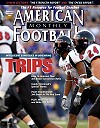AMERICAN FOOTBALL MONTHLY THE #1 RESOURCE FOR FOOTBALL COACHES
Article CategoriesAFM Magazine
|
The Speed Reportby: Dale BaskettFootball Speed Specialist © More from this issue Football has grown tremendously in the area of athletic development and strength development in recent years. The knowledge level in the weight room alone is nearly off the chart. The advent of the NSCA (National Strength and Conditioning Assoc.), which is now approximately 30 years old, provides certification for strength coaches nationally. The journals they supply are written by PHD scientists and are knee deep with physical science infomation which is almost beyond comprehension. However, while strength and power in the weight room is important and heavily emphasized it has a limiting carry over for speed enhancement on the field. Many athletes are very strong and powerful yet that alone doesn’t insure maximum results for speed development capability. Adapting the strength and po....The full article can only be seen by subscribers. Subscribe today!
|
|
|||||||
| HOME |
MAGAZINE |
SUBSCRIBE | ONLINE COLUMNISTS | COACHING VIDEOS |
Copyright 2025, AmericanFootballMonthly.com
All Rights Reserved





